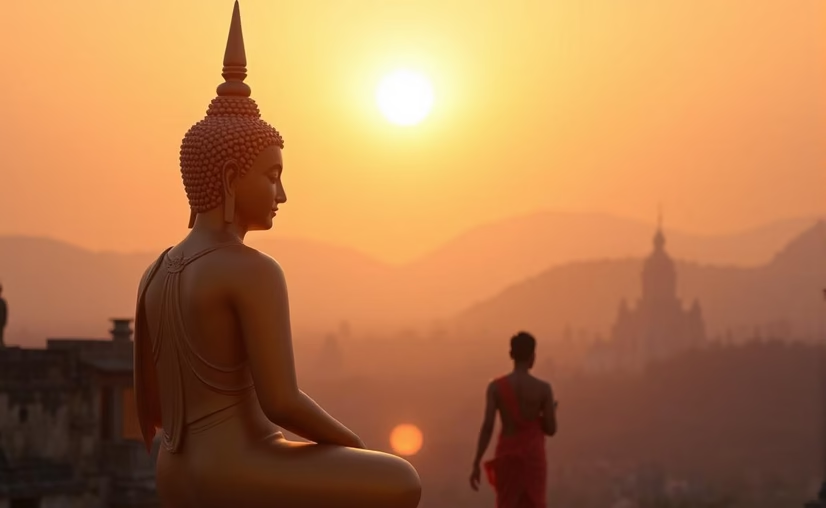
The unbreakable connection between Indian culture and Buddhism merges wisdom with compassion throughout the nation’s artistic and literary expressions as well as spiritual practices.
Indian culture developed an unchangeable connection with Buddhism which originated in India around the 5th century BCE and influenced its art forms along with philosophical ideas and societal ethics. India’s cultural heritage reflects Gautama Buddha’s teachings of wisdom and compassion through ancient stupas and contemporary festivals. My research into Indian traditions reveals the profound way Buddhist principles enhance India’s rich cultural mosaic.
The Roots of Buddhism in India
The founder of Buddhism, Gautama Buddha was born in Lumbini (c. 563 BCE), attained enlightenment in Bodh Gaya where he established Buddhism through the Four Noble Truths. The teachings of Buddhism became part of Indian thought when the Pali Canon was established in the 1st century BCE. During the 3rd century BCE Emperor Ashoka supported Buddhism which historian Romila Thapar observes significantly expanded its reach and allowed its moral principles to merge with Indian societal norms.
Core Contributions
- Ethical Framework: Compassion and non-violence (ahimsa) shaped Indian values.
- Monastic Tradition: Sanghas fostered learning and community service.
- Universal Appeal: Open to all castes, challenging social hierarchies.
Buddhism’s Impact on Indian Art and Architecture
Indian aesthetics underwent a transformation starting from the 3rd century BCE through the development of Buddhist art. The Sanchi UNESCO World Heritage Site stupas display detailed carvings which illustrate Jataka Tales. The artistic style of Gandhara combines Greek with Indian elements to represent scenes from the life of the Buddha. The Journal of Indian Art History published a 2020 study that determined more than 10,000 Buddhist sculptures remain which demonstrate both religious devotion and skilled craftsmanship.
Artistic Highlights
- Stupas and Viharas: Sanchi and Ajanta showcase Buddhist narratives.
- Buddha Icons: Mathura became the site of human-like representations of Buddhist figures during the 1st century CE.
- Cave Temples: Ellora and Ajanta blend meditation and art.
Discover further details about Ancient Buddhist Legacy in our article.
Buddhist Influence on Indian Literature
The literary tradition of India expanded through Buddhist texts including both the Pali Canon’s Dhammapada and Sanskrit narratives such as Ashvaghosha’s Buddhacarita from the 2nd century CE. These works served as the foundation for moral narratives and established poetic traditions. According to a 2019 study published in the Journal of Buddhist Ethics the Jataka Tales shaped regional folklore by introducing compassionate elements into Indian stories.
Literary Contributions
- Ethical Verses: The Dhammapada imparts eternal guidance through teachings such as “Mind precedes all phenomena.”
- Narrative Epics: Buddhacarita blends devotion and literary art.
- Regional Impact: Tamil and Bengali literature adopted Buddhist themes.
Read translations at Ancient Buddhist Texts.
Buddhism in Indian Festivals and Practices
Indian festivals integrate Buddhist teachings through celebrations like Buddha Purnima which honors both the birth and spiritual milestones of Buddha. Compassion defines the events through both meditation practices and charitable actions. According to a 2021 study published in the Mindfulness journal practices of mindfulness that originate from the Satipatthana Sutta affect both yoga and contemporary wellness methods.
Cultural Practices
- Festivals: Buddha Purnima brings communities together to perform prayers and give alms.
- Pilgrimage: Millions of people visit sacred locations such as Bodh Gaya where they develop spiritual connections.
- Meditation: Vipassana, revived in India, promotes inner peace.
Our post on Essence of Buddhist Sutras offers more detailed information.
Why This Bond Matters Today
The blending of Buddhism with Indian culture provides important teachings about living ethically and practicing tolerance. The artistic and literary works generate creative inspiration and mindfulness exercises boost mental health. A Heritage Studies report from 2022 states that Buddhist locations increase cultural tourism which helps strengthen India’s international standing.
Ways to Engage
- Visit Sites: Discover the cultural depths of Sanchi and Bodh Gaya through your visits.
- Study Texts: Read the Dhammapada at Access to Insight.
- Practice Mindfulness: Incorporate meditation into daily life.
- Support Heritage: Advocate for preservation of Buddhist monuments.
FAQ: Buddhism and Indian Culture
- Q: How did Buddhism shape Indian culture historically?
- A: The influence of Buddhism on Indian art, literature, and ethical principles led to the promotion of compassion and non-violence through the creation of stupas and texts as well as the implementation of social reforms.
- Q: What was the impact of Buddhist art on Indian heritage?
- A: Buddhist art significantly contributed to Indian heritage through the creation of stupas and cave temples which beautifully merged spirituality with artistic expression.
- Q: In what ways are Buddhist teachings integrated into Indian literary works?
- A: The Dhammapada and Jataka Tales provided ethical narrative inspiration for Sanskrit epics and regional folklore.
- Q: What is the current relevance of Buddhism’s relationship with Indian culture?
- A: Modern mindfulness practices, cultural tourism development and interfaith harmony efforts in India are directed by Buddhist principles of wisdom and compassion.
- Q: Where can one learn about Buddhist contributions to Indian culture?
- A: Tour UNESCO locations and explore the Ancient Buddhist Texts and Access to Insight website.
Conclusion: Celebrating an Enduring Bond
The enduring connection between Indian culture and Buddhism which is based on wisdom and compassion still influences artistic expression, spiritual practices, and moral living.